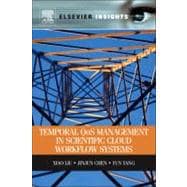
What is included with this book?
| Preface | p. ix |
| Acknowledgements | p. xi |
| About the Authors | p. xiii |
| Introduction | p. 1 |
| Temporal QoS in Scientific Cloud Workflow Systems | p. 1 |
| Motivating Example and Problem Analysis | p. 3 |
| Motivating Example | p. 3 |
| Problem Analysis | p. 5 |
| Key Issues of This Research | p. 7 |
| Overview of This Book | p. 8 |
| Literature Review and Problem Analysis | p. 11 |
| Workflow Temporal QoS | p. 11 |
| Temporal Consistency Model | p. 12 |
| Temporal Constraint Setting | p. 13 |
| Temporal Consistency Monitoring | p. 14 |
| emporal Violation Handling | p. 15 |
| A Scientific Cloud Workflow System | p. 17 |
| Novel Probabilistic Temporal Framework | p. 23 |
| Framework Overview | p. 23 |
| Component I: Temporal Constraint Setting | p. 26 |
| Component II: Temporal Consistency Monitoring | p. 28 |
| Component III: Temporal Violation Handling | p. 29 |
| Forecasting Scientific Cloud Workflow Activity Duration Intervals | p. 33 |
| Cloud Workflow Activity Durations | p. 33 |
| Related Work and Problem Analysis | p. 35 |
| Related Work | p. 35 |
| Problem Analysis | p. 36 |
| Statistical Time-Series-Pattern-Based Forecasting Strategy | p. 37 |
| Statistical Time-Series Patterns | p. 38 |
| Strategy Overview | p. 39 |
| Novel Time-Series Segmentation Algorithm: K-MaxSDev | p. 41 |
| Forecasting Algorithms | p. 43 |
| Evaluation | p. 46 |
| Example Forecasting Process | p. 46 |
| Comparison Results | p. 50 |
| Temporal Constraint Setting | p. 55 |
| Related Work and Problem Analysis | p. 55 |
| Related Work | p. 55 |
| Problem Analysis | p. 57 |
| Probability-Based Temporal Consistency Model | p. 58 |
| Weighted Joint Normal Distribution for Workflow Activity Durations | p. 58 |
| Probability-Based Temporal Consistency Model | p. 62 |
| Setting Temporal Constraints | p. 64 |
| Calculating Weighted Joint Distribution | p. 64 |
| Setting Coarse-grained Temporal Constraints | p. 65 |
| Setting Fine-grained Temporal Constraints | p. 66 |
| Case Study | p. 68 |
| Temporal Checkpoint Selection and Temporal Verification | p. 71 |
| Related Work and Problem Analysis | p. 72 |
| Related Work | p. 72 |
| Problem Analysis | p. 72 |
| Temporal Checkpoint Selection and Verification Strategy | p. 73 |
| Probability Range for Statistically Recoverable Temporal Violations with Light-Weight Temporal Violation Handling Strategies | p. 73 |
| Minimum Probability Time Redundancy | p. 74 |
| Temporal Checkpoint Selection and Temporal Verification Process | p. 75 |
| Evaluation | p. 76 |
| Experimental Settings | p. 76 |
| Experimental Results | p. 78 |
| Temporal Violation Handling Point Selection | p. 81 |
| Related Work and Problem Analysis | p. 81 |
| Related Work | p. 81 |
| Problem Analysis | p. 82 |
| Adaptive Temporal Violation Handling Point Selection Strategy | p. 83 |
| Probability of Self-Recovery | p. 83 |
| Temporal Violation Handling Point Selection Strategy | p. 84 |
| Evaluation | p. 85 |
| Temporal Violation Handling | p. 95 |
| Related Work and Problem Analysis | p. 95 |
| Related Work | p. 95 |
| Problem Analysis | p. 97 |
| Overview of Temporal Violation Handling Strategies | p. 97 |
| Temporal Violation Handling of Statistically Recoverable Temporal Violations | p. 98 |
| Temporal Violation Handling of Statistically Non-Recoverable Temporal Violations | p. 99 |
| A Novel General Two-Stage Local Workflow Rescheduling Strategy for Recoverable Temporal Violations | p. 100 |
| Description of the General Strategy | p. 100 |
| Metaheuristic Algorithm 1: GA | p. 103 |
| Metaheuristic Algorithm 2: ACO | p. 105 |
| Other Representative Metaheuristic Algorithms | p. 107 |
| Three-Level Temporal Violation Handling Strategy | p. 107 |
| PTDA for Level I Violations | p. 109 |
| ACOWR for Level II Violations | p. 110 |
| PTDA + ACOWR for Level III Violations | p. 110 |
| Comparison of GA- and ACO-based Workflow Rescheduling Strategies | p. 112 |
| Experimental Settings | p. 112 |
| Experimental Results | p. 115 |
| Evaluation of Three-Level Temporal Violation Handling Strategy | p. 122 |
| Violation Rates of Local and Global Temporal Constraints | p. 122 |
| Cost Analysis for a Three-Level Handling Strategy | p. 124 |
| Conclusions and Contribution | p. 127 |
| Overall Cost Analysis for Temporal Framework | p. 127 |
| Summary of This Book | p. 128 |
| Contributions of This Book | p. 130 |
| Appendix: Notation Index | p. 133 |
| Bibliography | p. 135 |
| Table of Contents provided by Ingram. All Rights Reserved. |
The New copy of this book will include any supplemental materials advertised. Please check the title of the book to determine if it should include any access cards, study guides, lab manuals, CDs, etc.
The Used, Rental and eBook copies of this book are not guaranteed to include any supplemental materials. Typically, only the book itself is included. This is true even if the title states it includes any access cards, study guides, lab manuals, CDs, etc.